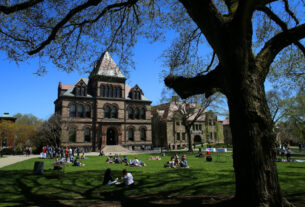This article was produced as part of JTA’s Teen Journalism Fellowship, a program that works with Jewish teens around the world to report on issues that affect their lives.
(JTA) — Like many Jewish teens, Ash Brave was nervous for their b’nai mitzvah. Memorizing the Torah portion, sending invitations, planning a party: It’s a lot for a 13-year-old to think about during what can already be an anxiety-filled age.
Despite the typical stress involved with preparing to enter the adult Jewish community, Brave cheerfully described their gender-neutral b’nai mitzvah last summer, recalling feeling “really supported [by] the whole synagogue.” For teens like Brave, an eighth grader from Boulder, Colorado who uses he and they pronouns interchangeably, gender-inclusive b’nai mitzvahs (often termed “b’mitzvahs”) offer an opportunity to come of age as their full selves.
Across the country, there is an expanding list of Jewish community centers, day schools, Hillels, organizations and more that include and celebrate LGBTQ+ identities. Many synagogues are following suit with the ceremonies they offer and the language they use. Some congregations are initiating these changes on their own; in other cases, the teens themselves are propelling the shifts.
Traditionally, most synagogues hold gendered b’nai mitzvah, with bar mitzvahs for boys and bat mitzvahs for girls (“b’nai” is the Hebrew plural form meanings “sons and daughters,” although it is technically masculine). Increasingly, many Jewish congregations are moving towards gender-inclusive b’nai mitzvah ceremonies. Synagogues like Har Hashem, a Reform synagogue in Boulder, have been offering these ceremonies for years at the request of their congregants. Because of these shifts, many gender nonconforming Jewish teens feel a deeper sense of belonging in their religious communities.
According to Rabbi Fred Greene of Har Hashem, the synagogue holds approximately 25 b’nai mitzvah ceremonies annually. In the last year, three of those were gender-neutral. Although the congregation has offered the option for almost five years, this is the first year they have had teens opting for the inclusive version. Greene said that the congregation also has teens who have transitioned after their b’nai mitzvah. He estimates that they have 5-7 teen congregants who identify as trans or genderqueer, meaning they do not identify with the gender they were assigned at birth.
B’mitzvahs at Har Hashem mirror the traditional gendered ceremonies in everything but language. “We have folks that don’t feel like a ‘ben’ or a ‘bat,’” said Greene, using the Hebrew words meaning “son” and “daughter.” “So we come up with other Hebrew terms, [such as] ‘beit,’ which is from “the house of [parent name].” He said that a number of changes can be made to the Hebrew to increase inclusivity, ranging from the creation of new terms to using the infinitive version of words that would otherwise be gendered. “We’re not treating anybody any differently, other than being sensitive to their needs,” he said.
Ruby Marx, a 16-year-old who uses she/her pronouns, had a gender-neutral b’mitzvah with Temple Beth Zion in the Boston area in early 2020, pre-pandemic. “I always knew that I was gonna have to have [a b’nai mitzvah]. But when it came time to start thinking about it, I was like, ‘I really don’t feel comfortable having a bat mitzvah.’ But I wasn’t comfortable [having a bar mitzvah], either. So someone suggested that I do something in the middle. And that felt right for me.”
Marx, who describes herself as gender-fluid, was the first teen in her congregation to have a ceremony that didn’t fall within either the bar or bat categories. In the years following, several other teens in her community have had gender-neutral ceremonies, including one having an upcoming ceremony in mid-March.
“I don’t think anyone else had done something like that before,” said Marx. “I think a lot of other kids started to feel comfortable being like, ‘oh, maybe that’s something I would want to do,’ or incorporating different things that they’re passionate about [into their ceremonies].”
For her ceremony, she wore a prayer shawl featuring rainbow trimming and various rock n’ roll patches from her favorite bands. Marx said that the most rewarding part of her experience has been being a trailblazer for inclusion in her congregation. “It definitely feels good to know that I can help other kids feel comfortable being who they are, because I know that sometimes I’m not always comfortable being who I am. It’s nice to know that kids can look up to me,” she said.
Gender inclusion in b’nai mitzvahs has been expanding for decades, beginning with the American introduction of the bat mitzvah in 1922 for the daughter of Rabbi Mordecai Kaplan, the founder of Reconstructionism, in New York City. Before that, only boys were allowed to engage in the important coming of age tradition. After Judith Kaplan’s ceremony, the custom slowly spread across the country in non-Orthodox synagogues. For decades, however, the ceremonies for girls differed from those offered to boys: In many synagogues, girls were not allowed to read from the Torah, and their services were held on Friday nights rather than Saturday mornings. Orthodox synagogues were slow in accepting the bat mitzvah, and still maintain strict gender roles in synagogue.
Ruby Marx playing the guitar during a benefit concert they held for their mitzvah project. (Courtesy Pamela Joy Photography).
As feminism progressed both outside and within Jewish communities, girls pushed to be allowed to read from the Torah and to be counted towards a minyan, the 10-person quorum required for public prayer. Full bat mitzvahs became an accepted norm. A similar pattern is now occurring for b’mitzvahs.
As a coming of age ritual, b’nai mitzvahs occupy a unique role in Jewish life. Their goal is to integrate young Jews into the broader community, signaling that they have the knowledge and maturity to take on adult ritual responsibilities. Because of this, many young trans Jews wish to have a ceremony that will fully reflect them as they become more involved in their community and beyond.
Brave, the Colorado teen, chose to have their ceremony gender-neutral to ensure it still fit them down the road. “I don’t really know what I’m going to identify as in the future, because identity is fluid. And while I may be comfortable right now with being closer to a male identity, [later] I might be less comfortable with that,” they said.
Marx, the gender fluid teen outside of Boston, said entering the community as her authentic self was an integral part of her choice. “I had grown up watching all my cousins, and then my sister, have [ceremonies]. Afterwards, they were a lot more independent in their Jewish identity. That was something that appealed to me, because I wanted to be connected to the Jewish community, but I wanted to do it in my own way,” said Marx.
B’mitzvahs aren’t the only gender-inclusive ceremony offered now. Many Reform congregations have also created ceremonies for gender transitions, Hebrew name changes, and coming out, often based on a curriculum offered by the Central Conference of American Rabbis. “These are holy moments of growth and transformation, and we want to be supportive in their journeys,” Rabbi Greene of Har Hashem said. Brave also had a ceremony with Har Hashem to change their Hebrew name, and the synagogue made them an updated yad — a pointer used in reading Torah — to match.
Teens who were not able to do their ceremony gender-neutral say having access to inclusive ceremonies would have increased the enjoyment and meaning of their b’nai mitzvahs. “I would have felt more like I was stepping into my own skin, instead of the skin [of someone] that I was pretending to be,” said Mica Newmark. The 17-year-old, who uses they/them pronouns, had a gendered ceremony at Nevei Kodesh, a Renewal synagogue in Boulder, before coming into their identity more. Since their ceremony, Newmark has grown apart from religion. “I don’t really relate anymore,” they said.
Even teens who were more clear on their identity struggled with having gendered ceremonies. Jay, a 15-year-old from Boulder, came out immediately following their ceremony. (Jay, estranged from a parent who has a leadership role in their synagogue, asked that their last name be omitted.) They found the ceremony “pretty stressful” and their coming out experience difficult, explaining that they wanted everyone to understand the concept of existing outside of the gender binary, but didn’t feel that was possible at the time. “I had really long hair then, so I wanted to cut it, and just be more me,” Jay said. “But I was really stressed, because I knew I was going to get misgendered at the ceremony.”

Keshet publishes a guide to “design and support affirming b’mitzvah celebrations.” (Keshet)
In the following years, Jay helped to institute the use of pronoun pins at synagogue events, as well as generally making an effort to educate community members on transgender issues. “I think [gender-neutral ceremonies] allow queer Jewish people to embrace their religion and continue to flourish within Judaism without feeling gendered,” they said.
Keshet, a national Jewish LGBTQ+ organization, published a guide for b’mitzvah ceremonies. “Celebrating the Age of Mitzvah: A Guide for all Genders” includes information from what to call the ceremony to what the dress code should be, all aimed at helping communities create inclusive and meaningful traditions.
The need for the resources came from synagogues and young congregants, said Jackie Maris, the Chicago education and training manager for the organization. “It’s not just Jewish boys and girls becoming Jewish men and women, it’s Jewish kids of all gender identities becoming Jewish adults,” said Maris. “Having a tool that helps guide everyone through that process, with gender-expansive language and rituals that include folks beyond the binary, is very needed.”
Keshet recently updated the resources. “Adjusting practices to make them more inclusive is what has always been done in Jewish tradition,” said Maris. “Even ancient practices and rituals have evolved over time, and because they are human constructed, we continue to humanly evolve them.”
However, a number of communities still mainly offer gendered ceremonies. Orthodox synagogues and others that are non-egalitarian have not made widespread shifts towards gender-neutral ceremonies.
Despite the strict gender separation in Orthodoxy, there is also a growing push for inclusion of LGBTQ+ individuals in these spaces. Organizations like Eshel, a nonprofit based in the United States and Canada, work to provide LGBTQ+ Orthodox jews and their families with resources for living and thriving in Orthodox Jewish spaces. Other organizations are targeted specifically at teens, such as Jewish Queer Youth, which engages queer youth from Orthodox, Hasidic and traditionalist Sephardi/Mizrahi communities.
“LGBTQ youth who live in a community that is accepting of LGBTQ people reported significantly lower rates of attempting suicide than those who do not,” reports The Trevor Project. For both Brave and Marx, their communities, families and friends were largely supportive of their decision to have non-gendered ceremonies. “It definitely felt like the community showed me a lot of love to be able to do that,” Marx said. “I was really able to be myself.”
By expanding inclusion, Jewish institutions are expanding their reach and impact, as well as creating more engaging communities. “I don’t think that God creates in vain. And so, while there’s a lot of people that are still learning, including myself, about issues relating to gender and identity, our role as a sacred space and a Jewish community is to have an open tent where folks can enter in any doorway they want, because there are no doors,” said Rabbi Greene of Har Hashem.
Brave said that their ceremony made them feel fully included in their synagogue. “It felt good to officially be a part of a community that I can’t really get taken away from,” they said.



